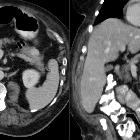VIPom




VIPomas are a very rare type of pancreatic endocrine tumors that secrete, and get their name from, vasoactive intestinal peptide (VIP). The clinical syndrome resulting from these tumors is commonly known as WDHA syndrome, as an acronym of the cardinal symptoms of watery diarrhea, hypokalemia, and achlorhydria.
Epidemiology
VIPomas represent <2% of pancreatic endocrine tumors . There are two epidemiological peaks in the diagnosis of these tumors, one peak in middle-age adults and another peak in children aged between two and four years .
Clinical presentation
Patients present with the classic clinical triad of :
- watery diarrhea that persists with fasting
- hypokalemia
- achlorhydria or hypochlorhydria
Pathology
VIP has many roles in the body, however importantly is involved in secreting fluid and electrolytes into the lumen, inhibiting of gastric acid secretion, and stimulating glycogenolysis . Over-activity of these functions explain the classic symptoms of secretory diarrhea and electrolyte deficiencies .
VIPomas are usually large (~5 cm) at presentation with most patients (~70%) having metastatic disease, especially involving the liver .
Location
- intrapancreatic (~75%): most commonly in the pancreatic tail
- extrapancreatic neurogenic (~20%): arising from the sympathetic chain
- extrapancreatic non-neurogenic (~5%): arising in the esophagus, bowel, liver, and kidney
Associations
- MEN 1 (rare)
Radiographic features
VIPomas share the radiographic features of other pancreatic endocrine tumors. See pancreatic endocrine tumor for a detailed discussion regarding these features.
Treatment and prognosis
Acute management includes fluid and electrolyte replacement, as well as symptomatic management of diarrhea with agents such as octreotide which inhibit VIP secretion . Once stable, surgical management is necessary, of both the primary tumor (e.g. distal pancreatectomy) and metastases (e.g. hepatic resection) .
History and etymology
The tumor and clinical syndrome were first described by John V Verner, an American endocrinologist, and Ashton B Morrison, an American pathologist, in their 1958 seminal paper .
Siehe auch:
und weiter:

 Assoziationen und Differentialdiagnosen zu VIPom:
Assoziationen und Differentialdiagnosen zu VIPom:
